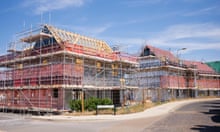Big pay increases for highly paid workers in London and the south-east have masked real wage cuts across large swathes of the economy and led to a widening in the UK’s geographical earnings gap, a leading thinktank has said.
A study from the Institute for Fiscal Studies (IFS) found that while workers in some sectors – such as manufacturing, education and hospitality – had fallen in inflation-adjusted terms, there had been significant rises for those employed in the business services sector, the City and IT.
Yet, despite evidence of labour shortages since the end of Covid-19 lockdown, many workers – including those in London – were now between 1% and 4% worse off than they were before the virus first arrived in the UK. There are more than 1m job vacancies, with employers saying they are having trouble hiring staff.
Using payroll data from HMRC, the IFS said pay growth since the start of the pandemic has been concentrated in well-paid parts of the economy that tended to be located in London.
That had led to real mean earnings for employees living in London rising by 5% since February 2020 – to £4,400 a month before tax – compared with a national increase of 2.7%. Workers who live in London’s commuter belt received a real pay rise of 4.5% on average.
Xiaowei Xu, the senior research economist at the IFS, said: “Inequality in mean earnings across the country had been falling in the two decades leading up to the pandemic, with the poorest areas seeing the highest pay growth. Since 2020 we have seen a reversal of this trend, with strong pay growth in business services benefiting London’s top earners.
“But not everyone in London has had a big pay rise. Middle earners in London have only seen their pay go up by 1.7% over the last three years, which is low by both national and historical standards.”
The IFS study showed the biggest real pay increases in the 2020-23 period had been enjoyed by workers in the energy and the administration and support sectors, which saw rises of close to 10%. Business services recorded increases of 8.6% and wages in finance – despite a fall from their peak in mid-2022 – were 7.6% above their pre-pandemic level. Earnings in information and communications were up by 5.5%.
after newsletter promotion
By contrast, there were 10 sectors in which inflation-adjusted earnings were lower than they were at the start of 2020. The biggest drop – close to 4% – was in the real estate sector, but there were also declines of 1% or more in mining and quarrying; accommodation and food; manufacturing; transportation and storage; construction; arts and entertainment; education; water; and public administration.









